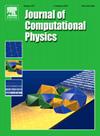A reinterpreted discrete fracture model for wormhole propagation in fractured porous media
IF 3.8
2区 物理与天体物理
Q2 COMPUTER SCIENCE, INTERDISCIPLINARY APPLICATIONS
引用次数: 0
Abstract
Wormholes are high-permeability, deep-penetrating, narrow channels formed during the acidizing process, which serves as a popular stimulation treatment. For the study of wormhole formation in naturally fractured porous media, we develop a novel hybrid-dimensional two-scale continuum wormhole model, with fractures represented as Dirac-δ functions. As an extension of the reinterpreted discrete fracture model (RDFM) [50], the model is applicable to nonconforming meshes and adaptive to intersecting fractures in reservoirs without introducing additional computational complexity. A numerical scheme based on the local discontinuous Galerkin (LDG) method is constructed for the corresponding dimensionless model to accommodate the presence of Dirac-δ functions and the property of flux discontinuity. Moreover, a bound-preserving technique is introduced to theoretically ensure the boundedness of acid concentration and porosity between 0 and 1, as well as the monotone increase in porosity during simulation. The performance of the model and algorithms is validated, and the effects of various parameters on wormhole propagation are analyzed through several numerical experiments, contributing to the acidizing design in fractured reservoirs.
求助全文
约1分钟内获得全文
求助全文
来源期刊

Journal of Computational Physics
物理-计算机:跨学科应用
CiteScore
7.60
自引率
14.60%
发文量
763
审稿时长
5.8 months
期刊介绍:
Journal of Computational Physics thoroughly treats the computational aspects of physical problems, presenting techniques for the numerical solution of mathematical equations arising in all areas of physics. The journal seeks to emphasize methods that cross disciplinary boundaries.
The Journal of Computational Physics also publishes short notes of 4 pages or less (including figures, tables, and references but excluding title pages). Letters to the Editor commenting on articles already published in this Journal will also be considered. Neither notes nor letters should have an abstract.
 求助内容:
求助内容: 应助结果提醒方式:
应助结果提醒方式:


